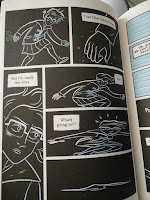The Gigantic Beard That Was Evil by Stephen Collins (2013)
, 28 April 2017
The Gigantic Beard that Was Evil is an awesome comic book. It has all those elements that make any comic to need of capitals because it has high standards regarding the quality of the Art and an unusual but poignant story.
Stephen Collins has a great drawing technique that mixes naturalistic drawing, illustration an vector-like images with cartoonish characters. Everything is drawn with precise lines, very tidy even when the story gets messy, but the use of charcoal pencil gives it texture, softness, chiaroscuro and warmth. I absolutely loved the framing and compositing of the vignettes and lettering, and how the text spreads organically throughout the page and the vignettes in unconventional ways.
What makes this book special to me, is that it has that little-something that elevates any graphic book from the cute and fun quality on to the excellent and timeless quality, and that's the story and the narrative. The book is well written, with a very concise and precise style, and takes readers into a humorous slightly Kafkaesque ride.
The Gigantic Beard... is a wonderful brilliant fable about how Society and Culture react to change, differences and "the other". It shows how Society fears people who are different because, by being so, they question the values and ways of life on which the majority stands; so Society will react badly to any person who deviates from the standards regarding behaviour, sexual orientation, gender role, or religious beliefs.
At the same time, it shows how Society hates and fears any transformation that shakes its core and questions its foundations. Surprisingly enough, History proves time and time again that, once those changes occur and the interrupters provoke the change, Society will come to recognise how important their disruption was for Society to advance; yet, Society criticised, ostracised, mocked, persecuted and/or killed those very people who were the engines of social change. Just two examples. The impressionist painters of the 19the century and the cubists and abstracts painters of the early 20th century were heavily criticised, disregarded and their talent questioned, but hey are the masters we all admire nowadays. The suffragists of the early 20th century were ridiculed, jailed and considered crazy for saying that women had a brain and were perfectly able and capable to decide and cast a vote on their own.
At the same time, it shows how Society hates and fears any transformation that shakes its core and questions its foundations. Surprisingly enough, History proves time and time again that, once those changes occur and the interrupters provoke the change, Society will come to recognise how important their disruption was for Society to advance; yet, Society criticised, ostracised, mocked, persecuted and/or killed those very people who were the engines of social change. Just two examples. The impressionist painters of the 19the century and the cubists and abstracts painters of the early 20th century were heavily criticised, disregarded and their talent questioned, but hey are the masters we all admire nowadays. The suffragists of the early 20th century were ridiculed, jailed and considered crazy for saying that women had a brain and were perfectly able and capable to decide and cast a vote on their own.
Finally, the story also tells us that, at times, change begins with one person changing, the rest will eventually follow up.
I read this book in the hard-copy edition, which is great. Very good quality thick grainy paper, well bound so one can openly comfortably without worry, and it's really durable.
I loved this book and the artwork. Original, enjoyable, thought-provoking and wonderful black-and-white Art.
I read this book in the hard-copy edition, which is great. Very good quality thick grainy paper, well bound so one can openly comfortably without worry, and it's really durable.
I loved this book and the artwork. Original, enjoyable, thought-provoking and wonderful black-and-white Art.





















